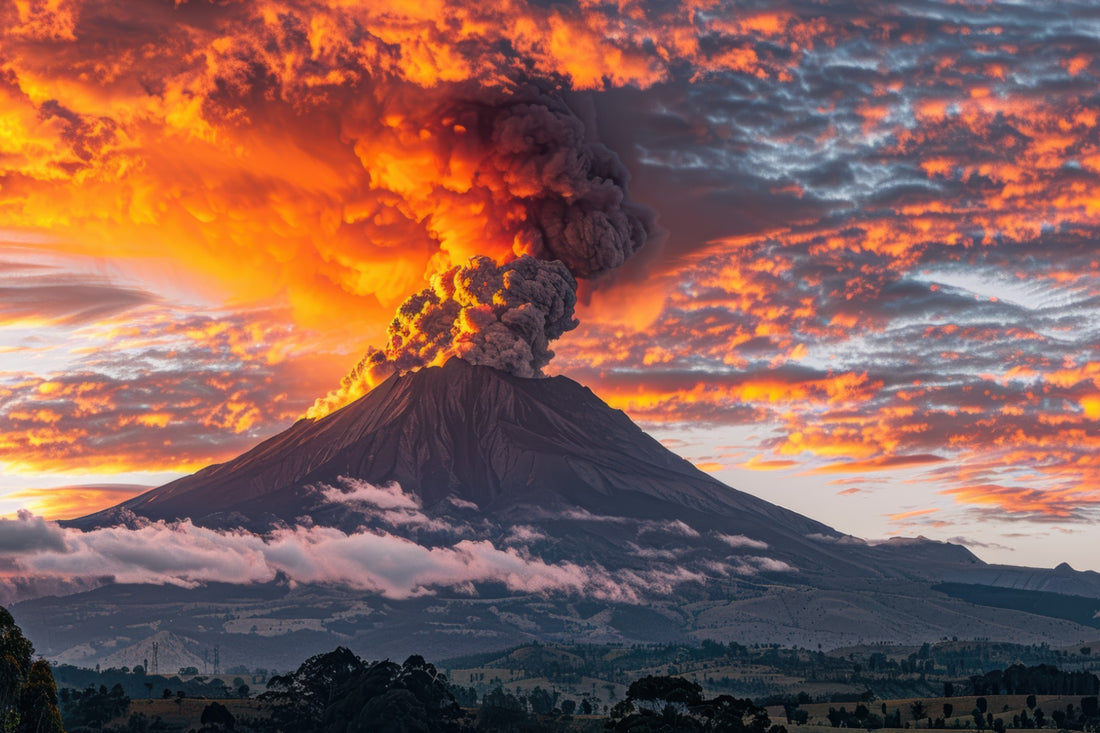
What to do before, during and after a Volcanic Eruption? | New Zealand
Share
What to do before, during and after a Volcanic Eruption? - Actions to Take
Aotearoa New Zealand finds itself in a very unique situation, being positioned along the collision zone of two of the Earth's largest tectonic plates, those being the Australian Plate and the Pacific Plate. One of the very things that makes this county so beautiful and rugged, also makes the country dangerously prone to natural hazards, such as Tsunamis, Landslides, Flooding, Earthquakes and Volcanic Eruptions. Being located directly on the pacific ring of fire, the risk of volcanic eruptions is ever present.
There has been a number of significant events in the last few years, including the eruption of white island volcano eruption or Whakaari volcano in 2019, in which 22 people died and and a further 25 were injured. At the time of writing this blog, the volcanic alert levels are at a heightened state due to recent minor volcanic unrest at White Island. Unfortunately due to the isolation of the volcano and there being no quick way off at the time, those in the vicinity had little chance to react and escape the eruption. As it stands there are 12 active volcanoes in New Zealand, many of which are located in and around the places that New Zealanders work, live and play. For this reasons it is important to know what to do should you be in the vicinity of a volcano when it erupts.
How to prepare for a Volcanic Eruption?
One of the most important steps you can take to prepare for a Volcanic Eruption is to find out about the Volcanic Risks in the community you live in. Check out your local Civil Defence Page or Emergency Management page and find out exactly what the risks are in you area. If you live in a community that is at risk of volcanic eruptions then you will want to add some more specific items to your Survival Kits and Grab Bags. This includes the following items;
- Dust Masks - P2 of N95 Certified (there is a lot of rubbish being sold online, ensure you buy from a reputable supplier as when the times comes you will want the masks to work like they should. These masks will not protect you from Volcanic Gases, which are incredibly toxic, and deadly.
- Some form of plastic sheeting, to be able to protect your valuable electronic items from ash fall.
- Supplies for cleaning, you will want to have a broom and shovel stored away to sweep up any ash fall as well as a good quality vacuum cleaner and spare bags for that as well.
- Some form of bags - heavy duty - to be able to collect and dispose of ash. You don't want to do this while the ash is still hot as it poses a fire risk.
- Ensure you have some glasses on hand as well, safety glasses, to protect your eyes from any debris, ash or flying objects.
Don't forget you may end up being stuck in your vehicle, if you are out and about, so it is vital that you keep some sort of supplies in your vehicle as well, including the above items, and your normal survival kit items such as food, water and so on. Also take a moment to sign up to any specific alerting systems that may be available in your area. We highly recommend Lert Info. They are the only emergency alerting system in New Zealand apart from the Mobile Emergency Alert System that the government runs. They offer a free email emergency alerting system as well as a paid text system, and their dedication to their roles is incredible.
Plan to limit your time outside as well, ash can be incredibly harmful to your health, know how to make sure your doors and windows close properly and how to keep ash out of the house.
Make sure you have a plan in place. Having an emergency plan is essential step in the Disaster Preparedness and you can check out our blog here on how to prepare an emergency plan, or follow this link to the get ready website which has all the information needed to do that in an easy to read format with a downloadable pdf. They even have the PDF in 21 other languages for those of whom English is not their first language.
Make sure you also have your Disaster Preparedness Kit, Survival Kit or Grab Bag ready to go and know where it is so you can find it in a hurry. Ensure that you go over the contents on a regular basis, at least once a year. If you need a good starting place, we have a check list here to work through.
What to do during a Volcanic Eruption?
Staying informed is vital during any emergency, and a Volcanic Eruption is no different. Listen carefully to local emergency information. Radio is going to be one of the main ways information will be provided, it is essential you have access to a Radio, and know which frequencies or radio stations will be broadcasting this information. Keep an ear out for evacuation information, when it is safe to come outside or when you need to evacuate further to a different area.
Stay indoors, in most cases this is going to be the safest place to be. Stay away from any volcanic ashfall areas. If you are outdoors at the time of an eruption, seek shelter inside a building or a car. If you are close to a volcano then head to higher ground and keep away from any valleys where lahars or mud flows might travel to.
Use damp cloths or clothing to block under windows and doors to stop any ash or smoke from coming into your property or vehicle.
If you rely on rain water, make sure you disconnect your tank from the down pipes. Disconnect your down pipes from the house so they don't get clogged also.
If you have close neighbours, don't forget to check on them, especially if they are not in a position to help themselves. Keep an eye on them and help if and where you can.
What to do after a Volcanic Eruption?
When it is safe to come back outside, then take a look at your house. Use the brush or broom to clear off your roof from ask deposits. Know that ash is very heavy and can easily collapse a building or roof. Also be aware that Ash is very slippery so be aware of your footing.
Be careful with you water supply as well, volcanic ash can contaminate your water supply and make it unsafe to drink. Check with the local authorities and use your emergency water supplies.
Ash can be incredibly dangerous to engines, as we have seen when planes and helicopters have tried flying through them, if there is a heavy ash fall then avoid driving in it. The ash can also make the roads very slippery and hinder your vision.
Avoid any exposure to ash that is not necessary especially while it is still falling. If you do have to go outside ensure you wear protective clothing.
- Eye Wear - Safety Goggles (avoid wearing contact lenses if you can, use your glasses. Ash can get trapped in your contact lenses and eyes and lead to scratching of the eyes.
- Wear good quality, sturdy footwear or gumboots.
- Make sure you have a good quality pair of gloves on hand also.
- Wear clothing that covers your arms and legs, brush off your clothing before you come back inside.
- Wear a good quality, genuine, P2 or N95 Mask.
Don't forget your pets and animals. They will need a clean source of drinking water and food, if possible keep them indoors as well and monitor their paws for any ash that they may bring in to the house, clean off or wash off their paws.
If you are cleaning up ash from your property consider watering it down lightly to stop it spreading in the air, like they do on construction sites, and make sure you wear a mask to protect your lungs. Not only is ash dangerous to engines but it is incredibly dangerous to your health and could cause considerable health issues.
If you have been evacuated, wait until you have official information that it is safe to return to your property.
Want to know more? Check out these websites for more information on preparing for and surviving a volcanic eruption.
- Interactive Map of Volcanoes in New Zealand
- GNS Geo Net Science Website - Volcanoes
- Geo Net Volcanic Alert Status
- Civil Defence Volcano Alerts and Information
- Visitors Guide to Volcanos in New Zealand
